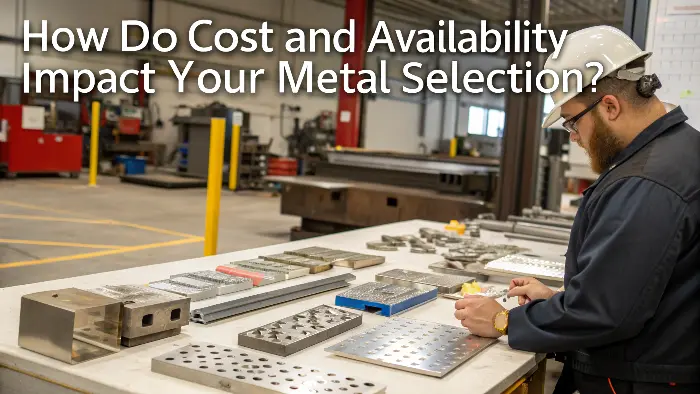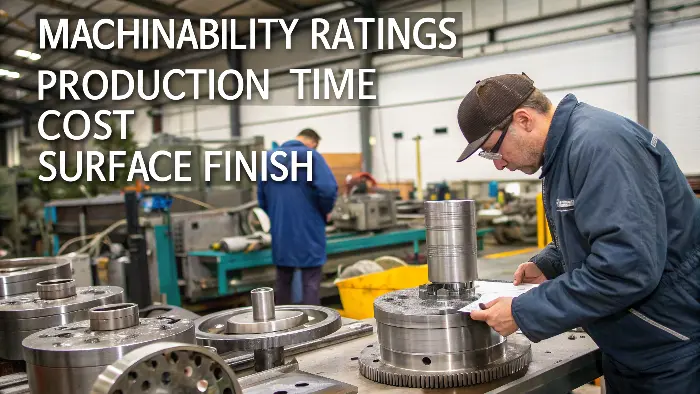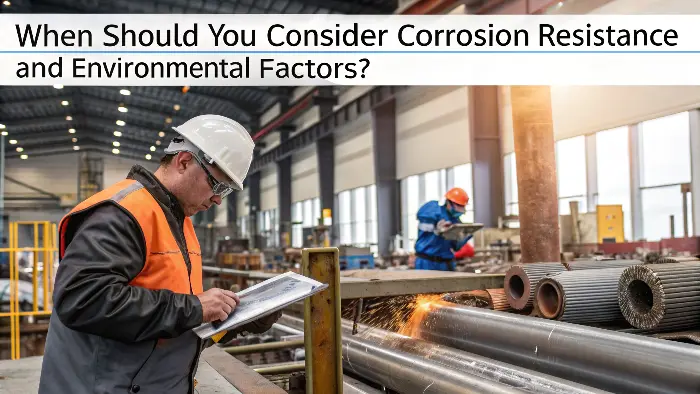Choosing the right metal is tough. Make the wrong choice, and your project fails. I’m here to help you decide.
To choose the right metal, consider its mechanical properties, cost, machinability, and environmental resistance. This framework helps you evaluate these key factors systematically for your engineering project’s success.
Selecting the perfect metal can feel overwhelming. I know, because I’ve faced this many times in my career. There are so many options. Each metal has unique strengths and weaknesses. Don’t worry. Let’s break down this decision process step-by-step. This way, you can pick the best material with confidence for your designs. I want to help you get it right from the start.
What Are the Most Important Mechanical Properties to Evaluate?
Stressed about material failure? Wrong properties mean poor performance. Let’s look at key mechanical aspects to ensure your design holds up.
Focus on strength (tensile, yield), hardness, ductility, and toughness. These properties determine how a metal behaves under stress, its resistance to deformation, and its ability to absorb energy effectively.
When I talk to engineers like Alex, who design high-tolerance parts, mechanical properties are always at the top of the list. These properties tell us how a metal will perform under the loads and stresses your part will experience. It’s not just about picking the "strongest" metal. It’s about picking the metal with the right combination of properties for the specific application.
Strength: Tensile vs. Yield
Strength is often the first thing engineers consider. We usually talk about two types:
- Yield Strength: This is the point at which the metal starts to deform permanently. If you exceed this, your part won’t return to its original shape. For many structural parts, this is a critical limit.
- Tensile Strength (or Ultimate Tensile Strength, UTS): This is the maximum stress a metal can withstand before it starts to fracture or break.
Hardness and Wear Resistance
Hardness measures a metal’s resistance to localized deformation, like scratching or indentation. Harder metals are generally more resistant to wear. This is very important for parts that rub against each other, like bearings or gear teeth. For Alex’s robotic arm joints, good wear resistance would be essential.
Ductility and Toughness
Ductility is a metal’s ability to deform under tensile stress before fracturing. Think of it like stretching a wire. Toughness is a metal’s ability to absorb energy and plastically deform before fracturing. A tough material can withstand impacts. Sometimes, a very strong metal can be brittle, meaning it breaks without much warning. For parts that might experience sudden loads or impacts, toughness is more important than just high strength. I remember a client, much like Alex, who initially chose a metal based purely on tensile strength for a robotic joint. It was strong, yes, but too brittle. We switched to a slightly less strong but tougher alloy, and the component performed beautifully, handling unexpected impacts much better. It’s about balance.
Here’s a simple comparison of some common metals:Property Aluminum (e.g., 6061-T6) Mild Steel (e.g., 1018) Stainless Steel (e.g., 304) Titanium (e.g., Grade 5) Yield Strength Moderate Moderate Moderate to High Very High Tensile Strength Moderate Moderate High Very High Hardness Low to Moderate Moderate Moderate High Ductility Good Very Good Excellent Moderate Toughness Good Good Very Good Good Understanding these properties helps you narrow down your choices significantly.
How Do Cost and Availability Impact Your Metal Selection?
Budget constraints hitting hard? Exotic metals look great but can break the bank. Let’s explore how cost and availability play a crucial role.
Metal cost includes raw material price and processing expenses. Availability affects lead times and price stability. Always balance performance needs with your project’s budget and timeline.

Every project has a budget. As an engineer or procurement professional, like Alex, you’re always trying to get the best performance for the best price. The "perfect" material isn’t perfect if it makes your project too expensive or if you can’t get it when you need it. I’ve seen many promising designs stall because of poor material cost planning.Raw Material Costs
The price of the metal itself is a major factor. Some metals, like common steels or aluminum alloys, are relatively inexpensive. Others, like titanium, nickel alloys, or specialized stainless steels, can be much more costly. The price per kilogram or pound can vary widely. It’s important to check current market prices, as they can fluctuate.
Processing and Machining Costs
The cost doesn’t stop at the raw material. Some metals are more difficult, and therefore more expensive, to machine or fabricate. Harder materials wear out tools faster. Some materials require special handling or slower machining speeds. These factors add to the overall cost of the finished part. This is where a platform like QuickCNCs can help, by connecting you with suppliers who have expertise in machining various materials efficiently.
Availability and Lead Times
Can you actually get the metal you want? Common alloys are usually readily available from multiple suppliers. However, more specialized or exotic metals might have limited suppliers and long lead times. This can significantly impact your project schedule. If you’re working on a tight deadline, like Alex often is with prototype revisions, choosing a readily available material might be more practical, even if it’s a slight compromise on ideal properties. I always advise clients to check availability early in the design process. Many engineers, especially those starting out, get excited by high-performance alloys. I always remind them that a material that’s perfect on paper but blows the budget or isn’t readily available can derail a project faster than anything. We once had a project where the ideal material had a 16-week lead time; we found a 90% suitable alternative available in 2 weeks, saving the project timeline.
Here’s a general idea of relative costs and availability:Metal Relative Raw Material Cost Relative Machining Cost General Availability Aluminum Alloys Low to Moderate Low High Carbon Steels Low Low to Moderate High Alloy Steels Moderate Moderate Moderate to High Stainless Steels Moderate to High Moderate to High Moderate to High Titanium Alloys Very High High Moderate Copper Alloys Moderate to High Low to Moderate Moderate Always get quotes for both material and manufacturing to understand the true cost.
What About Machinability and Manufacturing Processes?
Worried about manufacturing hurdles? A "perfect" metal can be a nightmare to machine. Let’s consider how your chosen metal will be processed.
Machinability ratings indicate how easily a metal can be cut, drilled, or shaped. This impacts production time, cost, and surface finish. Choose a metal compatible with your intended manufacturing processes.

As someone who started in a CNC shop, I can tell you that machinability is a huge factor in practical manufacturing. A material might have fantastic mechanical properties, but if it’s incredibly difficult to machine, it can lead to high costs, long lead times, and challenges in achieving the desired tolerances and surface finish. This is particularly important for engineers like Alex, who need precision components.Understanding Machinability Ratings
Machinability is often expressed as a percentage rating compared to a standard material, like AISI 1212 steel (which has a 100% rating). A higher rating means easier machining. Factors influencing machinability include the metal’s hardness, ductility, tensile strength, and thermal conductivity. For example, some soft, gummy materials like pure copper can be tricky, while some very hard materials are also tough to machine.
Impact on Tool Life and Machining Time
Metals with poor machinability cause cutting tools to wear out quickly. This means more tool changes, more downtime, and higher tooling costs. They also often require slower cutting speeds and feed rates, which increases the overall machining time per part. This directly translates to higher manufacturing costs. For tight tolerance work, like the ±0.01mm Alex often requires, good machinability helps in achieving consistent results.
Secondary Operations
Consider if your part needs secondary operations like welding, bending, or surface finishing (e.g., anodizing, plating). Some metals are easier to weld than others. Some respond well to certain finishing processes. For example, aluminum is easily anodized for corrosion resistance and color, while certain steels might need plating or painting.
From my early days in the CNC shop, I learned this lesson firsthand. We’d get designs specifying incredibly hard materials for simple parts. While strong, the machining time and tool wear were enormous, driving up costs. For Alex, who needs tight tolerances and fast turnarounds, selecting a metal with good machinability for the required strength is key. For example, certain aluminum alloys like 6061-T6 or 7075-T6 offer great strength-to-weight ratios and are a dream to machine precisely.
Here’s a general comparison of machinability for common metals:Metal Typical Machinability Rating (AISI 1212 = 100%) Notes Aluminum (e.g., 6061-T6) 90-150% Excellent, good chip formation, low tool wear. Brass (e.g., C36000) 100-120% (C36000 is often the standard) Excellent, often used for high-speed machining. Mild Steel (e.g., 1018) 70% Good, predictable. Stainless Steel (e.g., 304) 40-50% More challenging, work hardens, requires sharp tools. Stainless Steel (e.g., 303) 70-80% Free-machining grade, much better than 304. Titanium (e.g., Grade 5) 20-30% Difficult, low thermal conductivity, requires care. Always discuss machinability with your manufacturing partner. At QuickCNCs, we often advise on material tweaks that can improve manufacturability without compromising design intent.
When Should You Consider Corrosion Resistance and Environmental Factors?
Is your part exposed to harsh conditions? Corrosion can destroy your work. Let’s see when environmental factors become a top priority.
Evaluate the operating environment: temperature, moisture, chemicals. Metals like stainless steel or surface-treated aluminum offer excellent corrosion resistance, crucial for longevity in demanding applications.

A part might have the perfect strength and be easy to machine, but if it rusts or corrodes quickly in its operating environment, it’s a failure. For many applications, especially those exposed to the elements, chemicals, or high humidity, corrosion resistance is a non-negotiable requirement. Alex, when designing robotic components, might need to consider if parts are exposed to cleaning fluids, varying humidity levels, or even outdoor conditions.Types of Corrosion
Corrosion is the gradual destruction of materials by chemical or electrochemical reaction with their environment. Common types include:
- General Corrosion: Uniform attack across the surface.
- Galvanic Corrosion: Occurs when two dissimilar metals are in contact in a corrosive electrolyte.
- Pitting Corrosion: Localized corrosion that leads to small holes in the metal.
- Crevice Corrosion: Occurs in tight spaces or crevices.
Common Corrosion-Resistant Metals
Some metals are naturally more resistant to corrosion than others:
- Stainless Steels: Alloys of iron, chromium (minimum 10.5%), and often nickel and molybdenum. The chromium forms a passive oxide layer that protects the surface. Grades like 304 and 316 are very popular.
- Aluminum Alloys: Aluminum naturally forms a protective oxide layer. Certain alloys are more resistant than others. Anodizing can further enhance this protection.
- Titanium Alloys: Excellent corrosion resistance in many aggressive environments, including saltwater.
- Copper Alloys (Brass, Bronze): Good resistance to atmospheric corrosion and saltwater, though they can tarnish.
Protective Coatings and Treatments
If the ideal base metal for mechanical properties isn’t inherently corrosion-resistant, you can often apply protective coatings. These include:
- Painting: A common and cost-effective solution.
- Plating: Coating with a more resistant metal like zinc (galvanizing), nickel, or chromium.
- Anodizing: An electrochemical process for aluminum that creates a durable oxide layer.
-
Powder Coating: A durable polymer finish.
I worked on a project for a marine application some years ago. The initial design used a standard carbon steel to save costs. Within months of deployment, severe corrosion became a significant issue, leading to component failure. We had to re-machine all the parts in 316 stainless steel. It was a costly lesson, but it taught me that skimping on material selection for parts in harsh environments is always false economy. Considering the environment upfront saves a lot of headaches and money later.
Here’s a brief look at how some metals fare in different environments:Metal General Atmosphere Saltwater Acids (Weak) Alkalis (Weak) Aluminum Good to Excellent Fair to Good (alloys vary) Poor to Fair Poor Carbon Steel Poor (rusts) Very Poor Very Poor Fair Stainless Steel (304) Excellent Good Fair Good Stainless Steel (316) Excellent Excellent Good Excellent Titanium Excellent Excellent Excellent Excellent Always match your metal choice to the specific environmental challenges your part will face.
Conclusion
Choosing the right metal involves balancing properties, cost, manufacturability, and environment. This framework helps you make informed decisions for successful projects.


